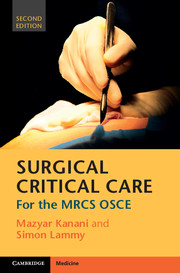3 - Circulation
from Section 1 - Ward care (level 0–2)
Published online by Cambridge University Press: 05 July 2015
Summary
Assessment
Cardiac assessment
Which basic investigations may be used in assessing cardiovascular function?
Following basic clinical examination of the praecordium during a cardiovascular examination, investigations may include
Non-invasive
Pulse: this is a clinical assessment of rate and rhythm, e.g. radial artery, and volume and character, e.g. carotid artery
Non-invasive blood pressure (NIBP): this employs a sphygmomanometer, e.g.manual measurement, or a Dinamap®, e.g. automated monitoring.The Dinamap® can measure absolute values, mean and pulse pressure, but mercury measurement is more accurate
Electrocardiograph (ECG):measures the rate, rhythm, intervals, axis and waveforms
Transthoracic echocardiography (TTE):measures systolic function, cardiac filling, valve function general morphology and
blood flow
Radiology: plain chest radiography (cardiothoracic ratio), CT, MRI
Other non-invasive assessments include the clinical evaluation of GCS, as a marker of cerebral perfusion, capillary refill time and urine output as markers of cardiac index (CI) and organ function, e.g. renal function.
Invasive
Intra-arterial blood pressure (IABP): e.g. radial arterial line, exhibits a continuous arterial waveform and beat to beat variation
Central venous catheter (CVC): e.g. internal jugular vein, measures the central venous pressure (CVP) or its response to fluid challenges and inotropes.The waveform may be continuously displayed
Pulmonary artery flotation catheter (PAFC): provides both direct and derived measures of left heart function, e.g. cardiac output. It also measures systemic and pulmonary vascular resistance, e.g. pulmonary artery capillary wedge pressure (PACWP), oxygen delivery, SaO2 and demand
Transoesophageal echocardiography (TOE [TEE]): Gives a more detailed picture of the left heart and thoracic aorta than transthoracic echocardiography
Cardiac catheterisation and coronary angiography: is the gold standard diagnostic procedure regarding the structure and function of the heart
Other invasive assessments of cardiac index and peripheral organ perfusion include
Arterial blood gases (ABGs): to assess the acidosis and base excess associated with anaerobicmetabolism following poor tissue perfusion
Biochemistry: rising serum lactate levels indicate a poor cardiac index
Gastric tonometry: adequacy of splanchnic perfusion is estimated fromgastric intramucosal pH measurements using a gastric probe.The gut is the first organ system to reflect a poor peripheral perfusion
Arteriovenous oxygen difference (a–vO2): oxygen extraction is increased in cases of poor organ perfusion due to relative stagnation
[…]
- Type
- Chapter
- Information
- Surgical Critical CareFor the MRCS OSCE, pp. 69 - 155Publisher: Cambridge University PressPrint publication year: 2015

